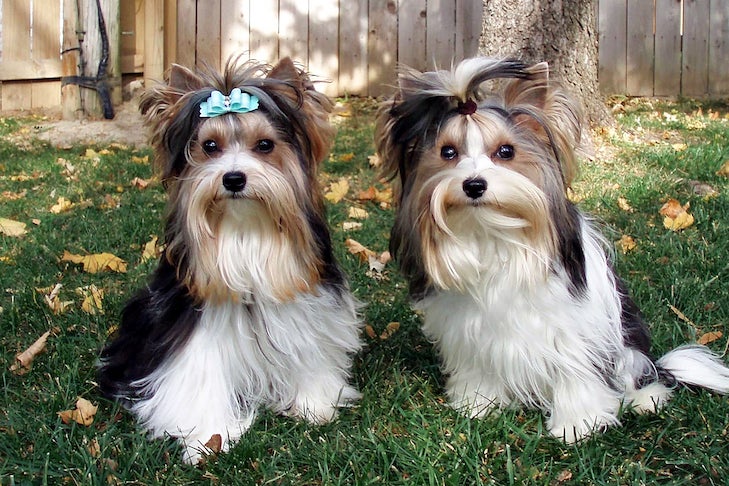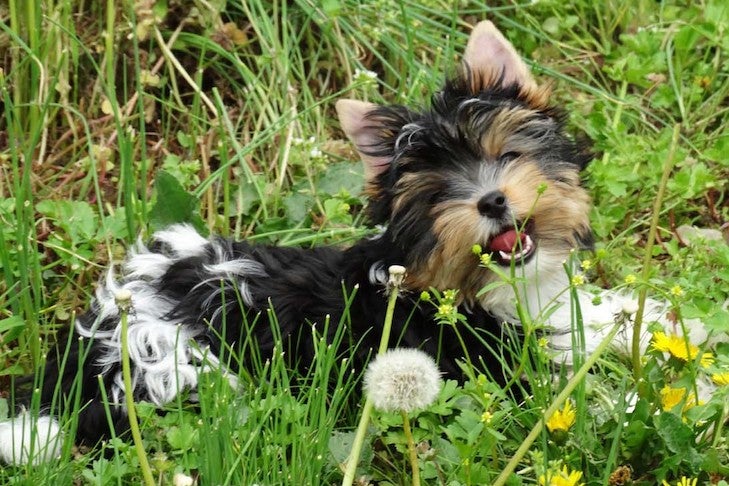
In the COVID-19 era, you better be careful when uttering the word fever.
But rest assured, Biewer Fever is all about smiles and plenty of engaging inquisitiveness tossed in for good measure.
Welcome the Biewer (pronounced Beaver) Terrier to the American Kennel Club’s full-fledged competition family in the Toy Group. As the AKC’s 197th recognized breed, the beguiling little character has all the qualities to become America’s next top dog.
First imported into the United States in 2003, it has navigated its way up the AKC ladder to full recognition in record time, gaining acceptance into AKC’s Foundation Stock Service in 2014, the Miscellaneous Class in July 2019, and now into the total limelight. There are presently 1,424 registered with AKC.
So what distinguishes the four-to-eight-pound Biewer from its toy teammates?
“A long-haired, tri-colored dog with a soft-silky coat and its feathered tail curled over its back. Add to that a neat ponytail atop its head and a proud sassy walk,” says Myrna Torres, of Sierra Madre, California, one of the co-founders of the breed in the U.S., along with Gayle Pruett, of Jemison, Alabama. Torres is president and Pruett, vice president, of the parent Biewer Terrier Club of America.

Where Did Biewer Terriers Come From?
There has always been a debate on the origin of the breed, say Torres and Pruett, which takes its name from the late Werner and Gertrud Biewer, Yorkshire Terrier breeders in Germany, who in the 1980s began producing tricolor Yorkies. The couple referred to them as black and white Yorkshire Terriers and later as the Biewer Yorkshire, neither of which was recognized by the German Kennel Club. Ironically, Mrs. Biewer joined the Biewer Terrier Club of America in 2007 to support Torres’ and Pruett’s goals for her namesake breed.
It’s unknown whether the plucky Biewer is the only breed that remains unrecognized in its country of origin, but there’s no doubt that it is about to find itself on a fast track in the U.S.
Things changed dramatically in 2007 for this tiny terrier when Mars Veterinary geneticists, studying the DNA from 10 Biewer Terriers, determined that it was a bonafide breed, stemming from the dominant traits of four others – Yorkshire Terrier, Maltese, and Havanese/Bichon Frise – making it the first breed in history to be recognized as a purebred as a result of a genetic study.
This set the stage for a major division between the breeders with different theories and those who still believed it was a Yorkie and were not convinced by scientists’ finds. Consequently, these early outcasts were often regarded as “mutts,” designer dogs, or a Yorkshire Terrier with a recessive piebald gene.
Becoming AKC-Recognized
Since Pruett brought her first Biewer into the United States from Germany in 2004 she has been shepherding its development with imports and a breeding program of her own – with equal input from Torres more than 2,000 miles away.
“I quit importing after the first year of purchasing them from Germany,” Pruett explains. “I was looking for the best examples of the breed and bought pretty much everything I was offered – about 15 in all. Some were never bred.”
Their collaboration started when Torres’ daughter, Stacie Nyborg, found this “new and very rare breed online” called a Biewer Yorkshire Terrier. That piqued Torres’ curiosity, who quickly set out to find one. This led to her connection with Pruett. The Alabaman brought Torres’ puppy to her in Southern California and the two bonded, forging a commitment toward the breed’s AKC recognition.
Their distance apart has not been a barrier, Torres says. “We generally speak daily, and have developed a deep friendship that goes well beyond dogs.” Their focus in recent years has not been on breeding, rather staying on course to establish a standard.
So why is this dog with terrier attached to its name, been placed in the Toy Group? Pruett replies, “Although it has many terrier qualities, it’s much more of a sit-in-your-lap dog.” To which Torres adds, “It has the heart and soul of a terrier and can be quite the little hunter.”

All About the Biewer
What are the perky Biewer’s trademarks?
“It is very adaptable,” emphasizes Pruett, “and loves the snow as well as the beach and can keep up with the best of hikers.” Torres says, “They do as well on the farm as in a house or apartment.” Case in point, Torres resides in a residential community and Pruett on 27 acres.
Don’t be fooled by its diminutive stature, either, for you will find this versatile character in Agility, Rally, Dock Diving, and Obedience competitions in addition to the Conformation ring.
This is not a low-maintenance dog, however. If you keep your Biewer in a full long silky coat, Torres recommends daily or every-other-day grooming. With a short puppy cut, weekly brushing will suffice. It is one of few breeds that includes a strict grooming clause in the standard. The Biewer’s coat texture ranges between cotton and silk, which the two characterize as “soft silk.”
Pruett adds, “We do not want our breed to start looking like certain others, and consequently enforce the ponytail atop the head. No teasing the hair to make poofs on the forehead and no ponytail in the middle of the forehead.
“Conformation and coloring set it apart. The Biewer is little longer than tall, making it an off-square, although square is acceptable.”
The only health issue to surface thus far, according to Pruett, is a sensitive gastrointestinal system, which she says can be controlled with a good diet.
Developing a sound temperament has been a top priority. “They are dedicated to their owners with a whimsical, childlike behavior. Half of my dogs smile and carry a toy around all the time,” says Pruett. “When they get excited, they run zoomies throughout the house.”
- Gertrude Biewer holds the last Biewer Terrier born at the Von Friedheck Kennel in Germany. She and her husband, Werner, were founders of the breed in the 1980s.
- Gayle Pruett, the breed’s co-founder in the United States, grooms one of her dogs before a show.
- Myrna Torres is the other breed matriarch, along with Pruett, in the United States.
The Future of the Biewer Terrier
You will find Biewers just about anywhere, but their price tag isn’t cheap. The average cost for a show or breeding dog ranges from $3,500-$4,000. Pet quality Biewer puppies go for $1,000-$2,500.
Moving forward the two have concerns, however. “Our best advice,” say Torres and Pruett, “is buyer beware. There are already many puppy mills out there cranking out inferior and unsocialized dogs. So be careful and go to our club’s website to find reputable breeders.”
Torres adds, “Don’t be taken in by fancy websites and pretty pictures. If a breeder refuses to offer any references, it’s time to run and do your homework.”
The Biewer is still a newcomer, hence Pruett and Torres recently addressed breeders: “Acquiring dogs that completely fit the standard is going to take a while, so do not take offense when another breeder tells you that your dog needs more color, the ears are too big, the body or legs are long and so on. Do not try to fix all the problems all at once, either. You may have to work on conformation first and when you have accomplished that, move on to the next issue.
“Established breeds have gone through many changes and standards before achieving the look they have today.
“We’re also worried that both professional handlers and owner-handlers may over-groom our breed and have it looking like the Yorkie or Shih Tzu in the ring. It needs to establish its own identity.”
Pruett concludes, “We are the caretakers for a breed in its infancy. If breeders stay conscientious about health issues that may arise and eliminate them now, in 50 years followers may proudly have an opportunity to say this breed is free of any major genetic concerns.”




